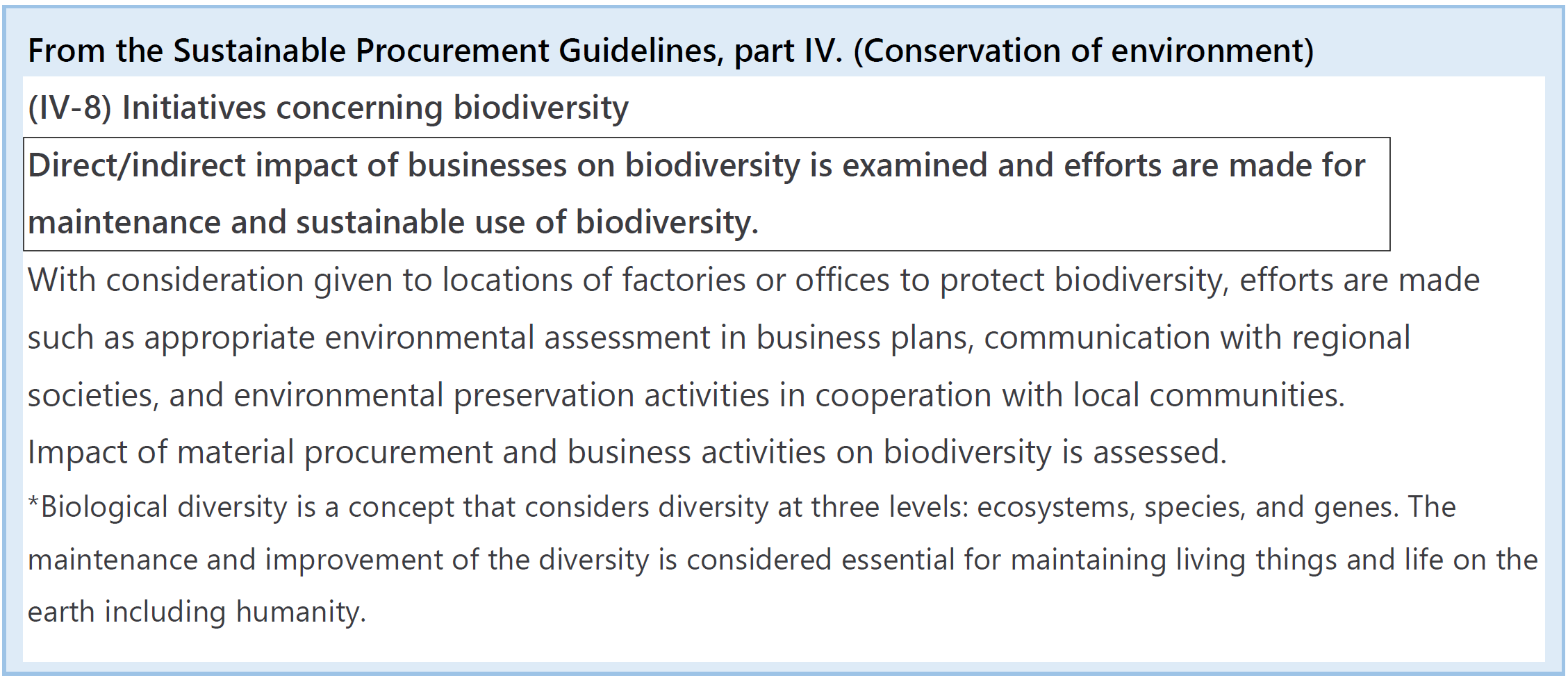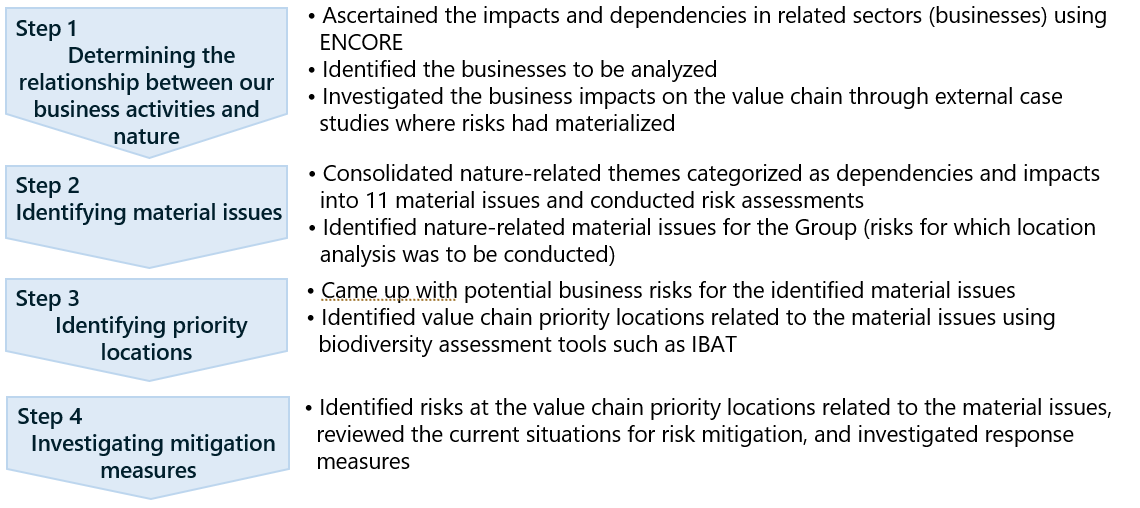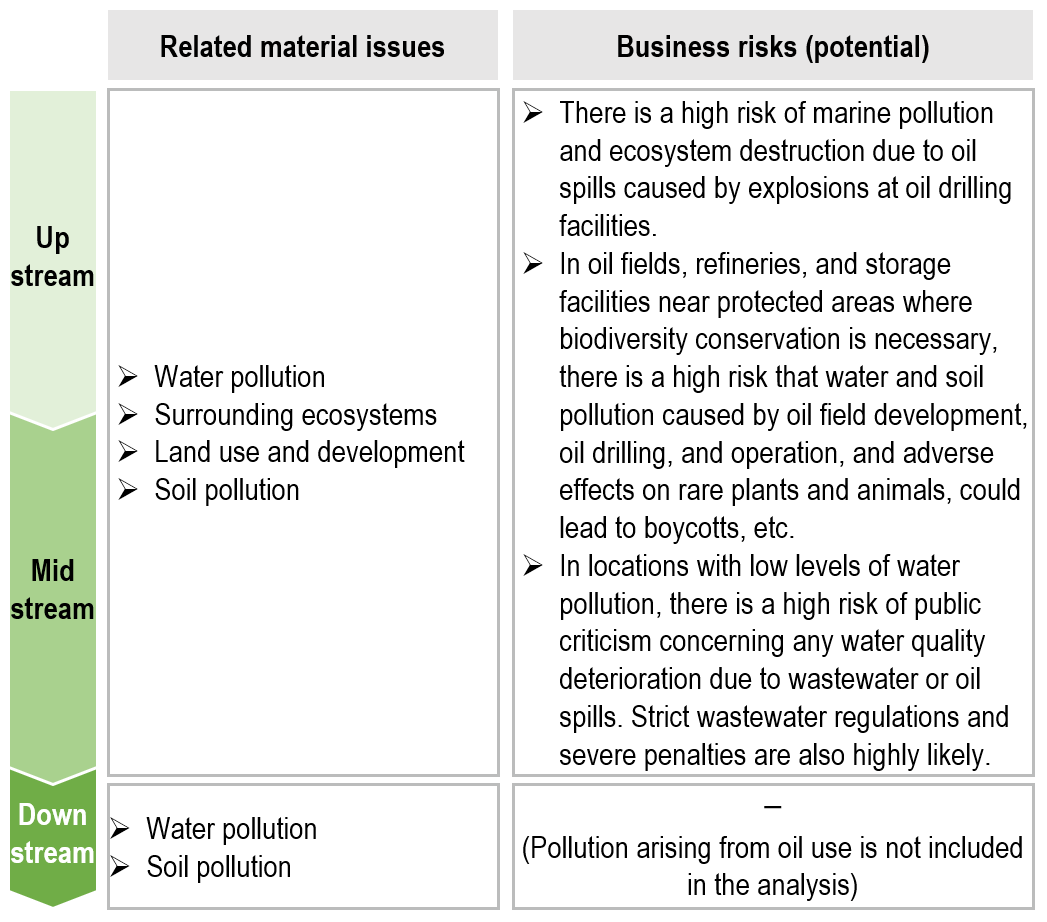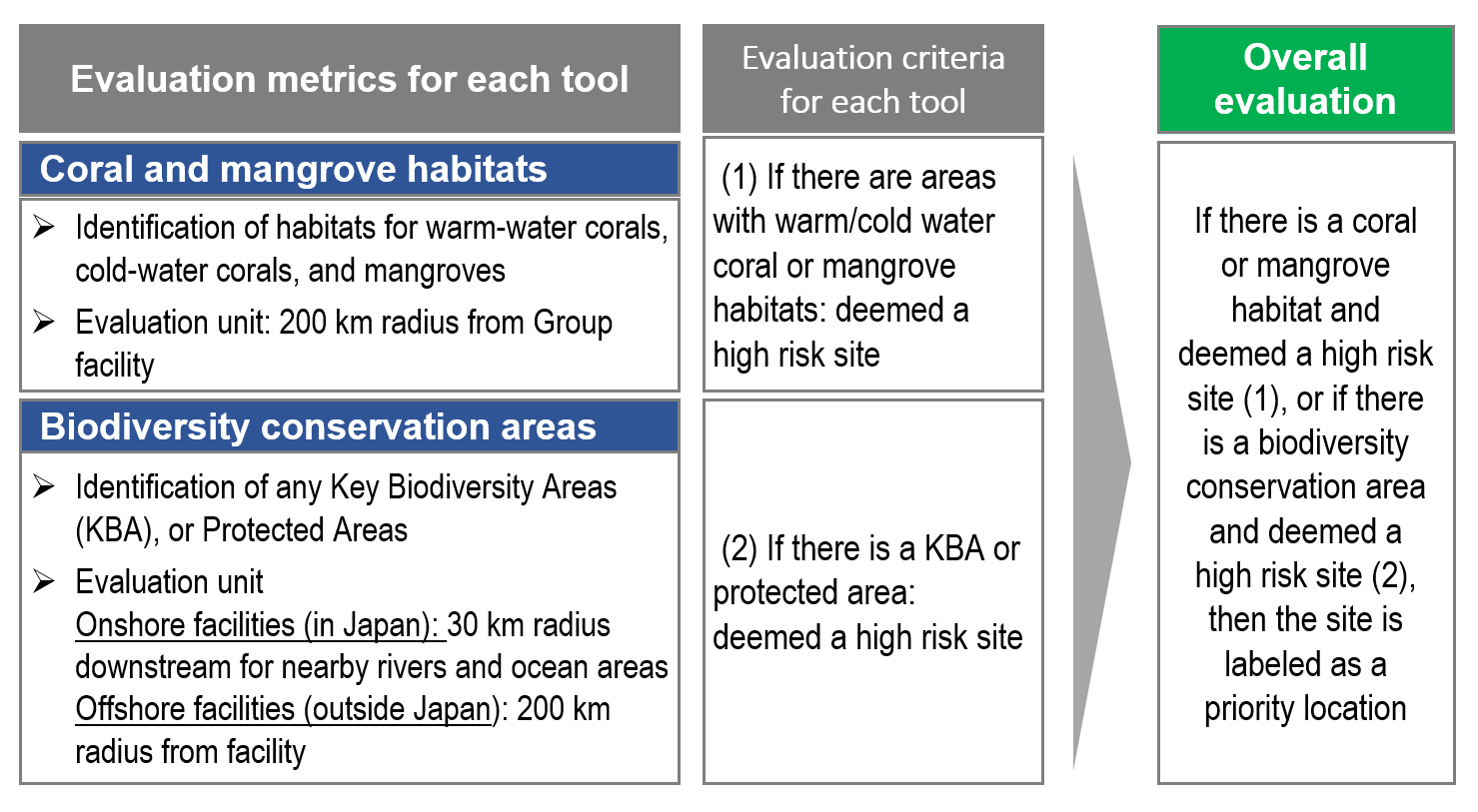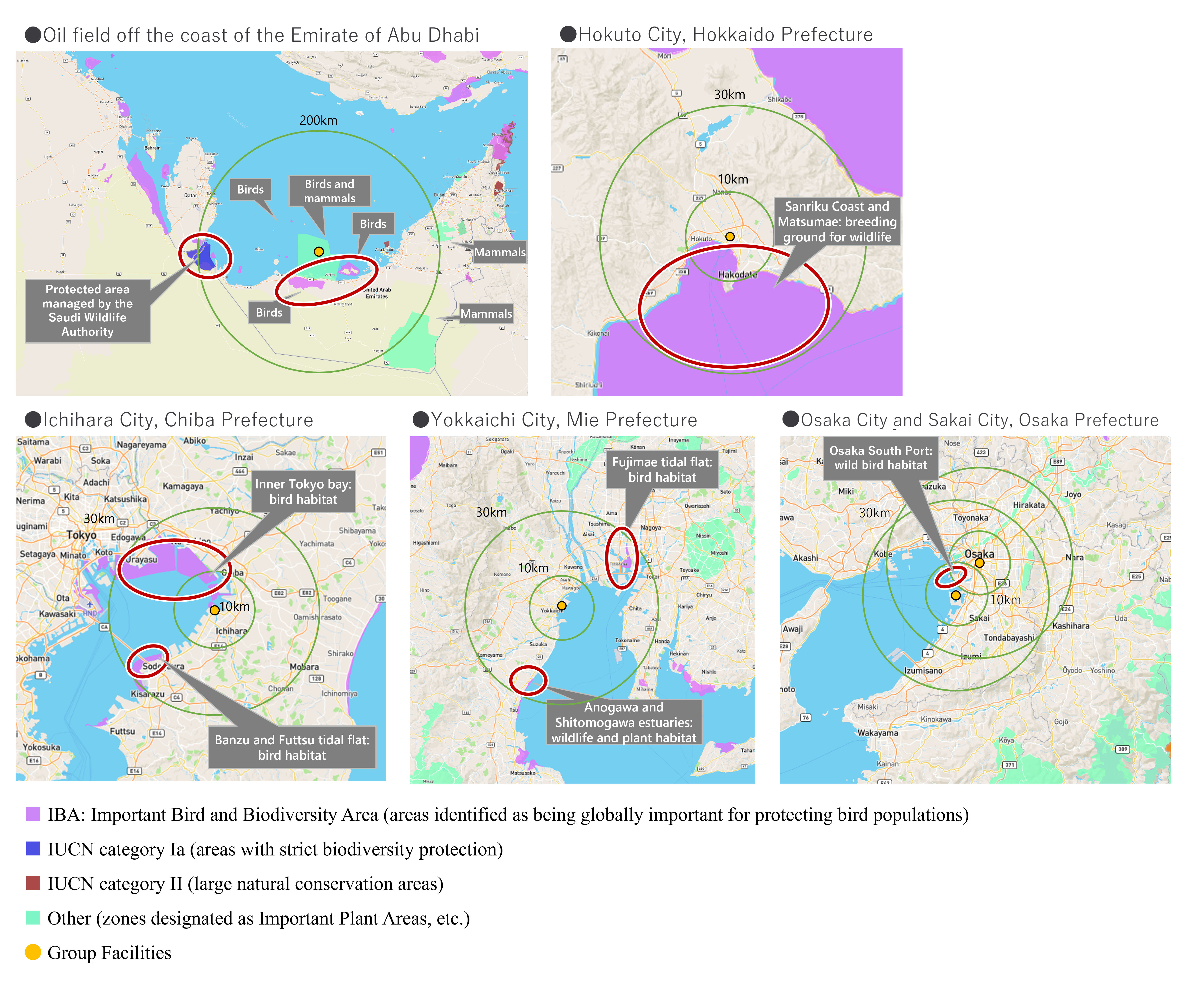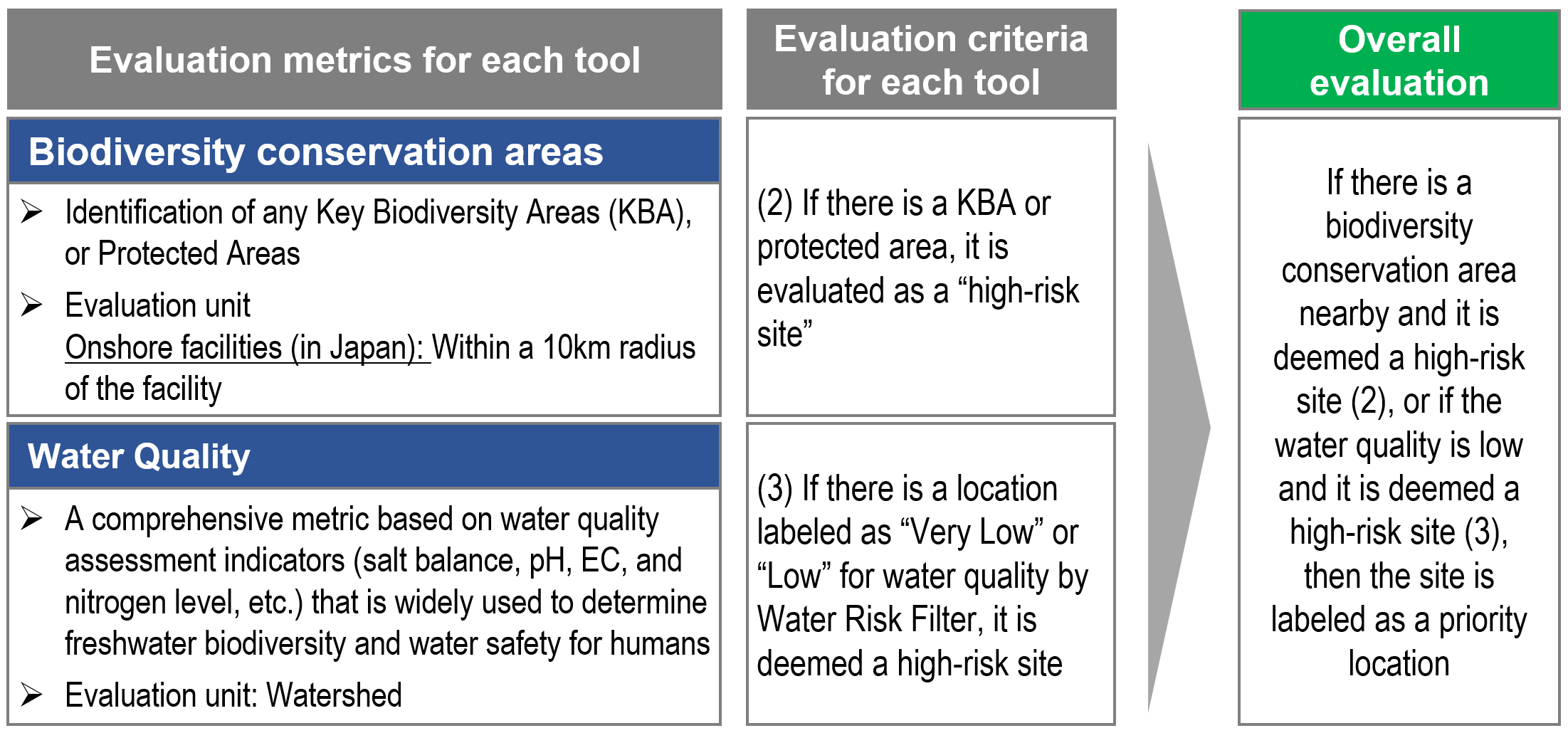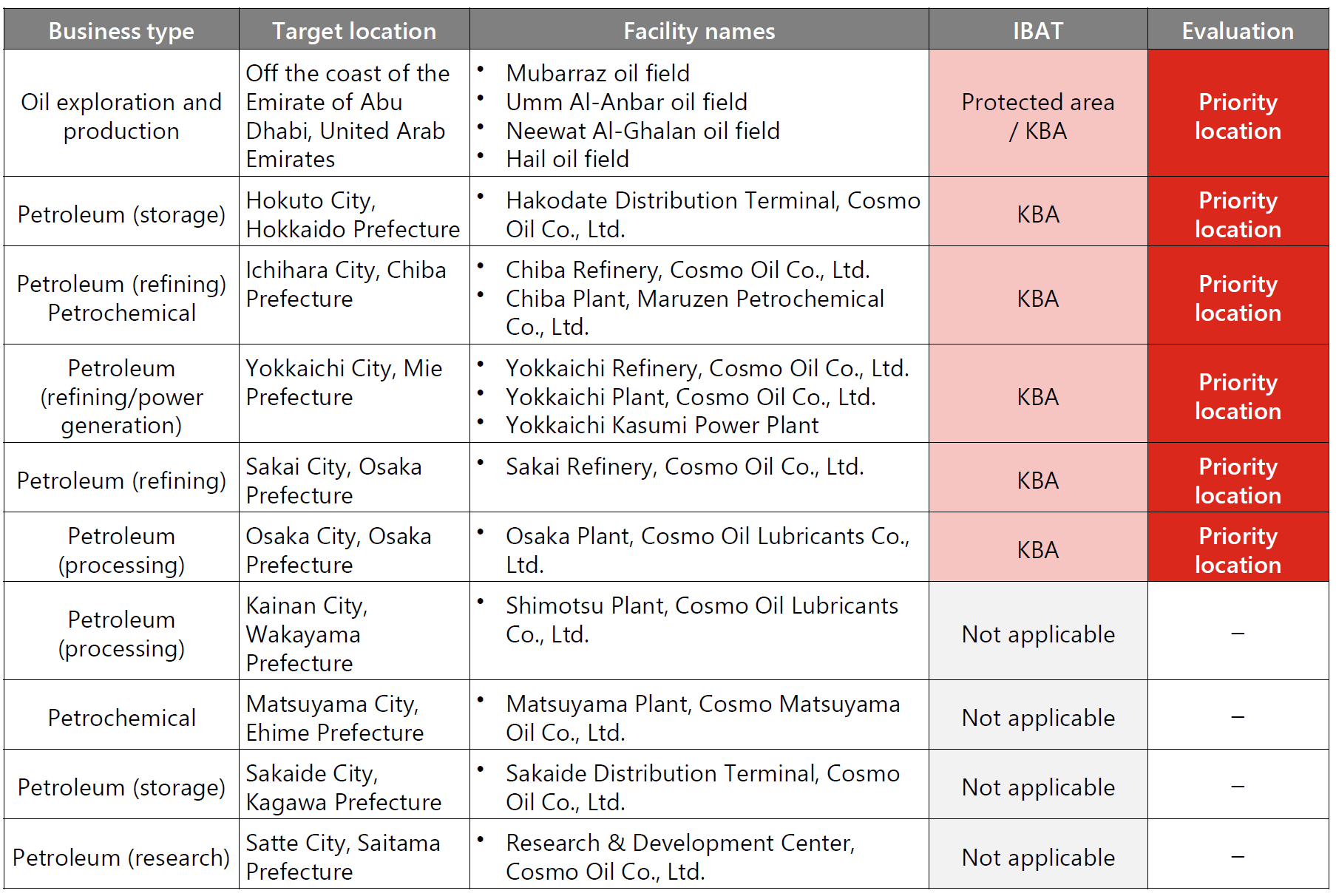Approach to Natural Capital and Biodiversity Conservation
While working to develop and provide petroleum products, the Cosmo Energy Group also engages in initiatives such as renewable energy operations, biodiversity conservation, and sustainable use of natural capital. We are focusing on various activities to help preserve the global environment as a priceless inheritance for future generations.
Based on the Group Management Vision, “In striving for harmony and symbiosis between our planet, man and society, we aim for sustainable growth towards a future of limitless possibilities,” the Cosmo Energy Group is striving to realize its Basic Concept of Sustainability, including “Harmony and symbiosis with the global environment.” The Group’s Code of Conduct states that officers and employees must take measures to mitigate climate change, minimize environmental impact, conserve water and marine resources, and enforce rigorous soil preservation measures. We also have an Environmental Policy in place to ensure that all our business activities are conducted in harmony and symbiosis with the environment.
Cosmo Energy Group’s Environmental Policy
The Group’s Environmental Policy includes a basic approach to the conservation of natural capital and biodiversity. Under this policy, we are committed to environmental preservation as well as the conservation and improvement of biodiversity, as we seek to make effective use of resources and sustainably use natural capital.
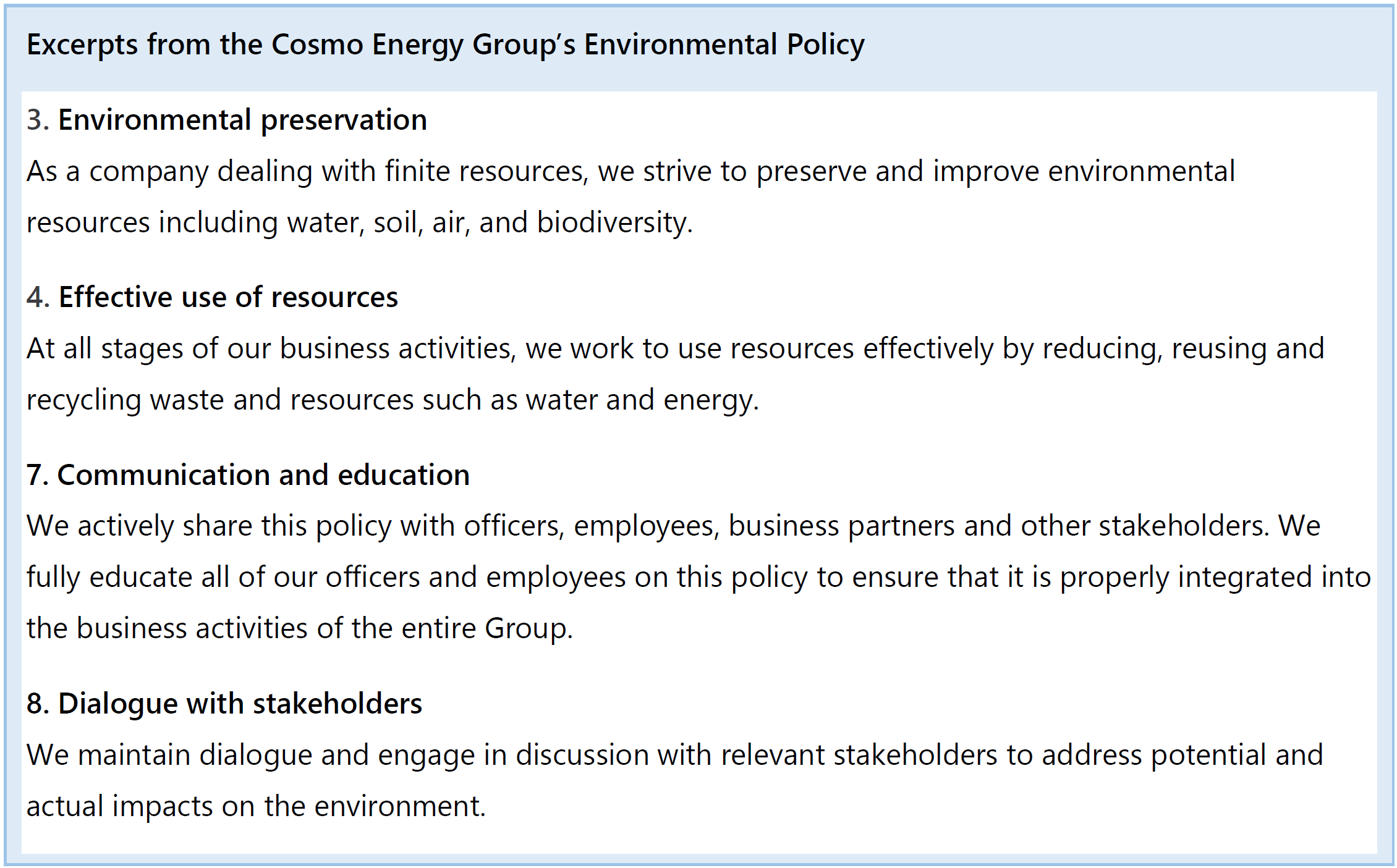
To date, the Group has been working to reduce factors that affect the natural environment by striving to minimize its environmental impact. These efforts include climate change countermeasures, pollution prevention, chemical substance management, as well as circular economy efforts and resource conservation.
To further promote these initiatives, we participate in initiatives based on the Declaration of Biodiversity by Keidanren (Japan Business Federation) and the 30by30 Alliance for Biodiversity. Accordingly, we implement initiatives to conserve ecosystems and take biodiversity into account across all of our business activities.
The Group also participates in the TNFD Forum, which involves organizing and disclosing past activities in line with the TNFD framework. We are also working to conserve the natural environment, including biodiversity, by properly assessing and disclosing risks and opportunities related to natural capital and biodiversity across our entire value chain.
For more details on our collaboration with external organizations, please refer to “Initiatives Endorsed and Supported, Participating Organizations.”
Keidanren Biodiversity Declaration Initiative
Participation in the 30by30 Alliance for Biodiversity
Participation in the Taskforce on Nature-Related Financial Disclosures (TNFD) Forum
Responding to the Recommendations of the Task Force on Nature-Related Financial Disclosures (TNFD)
The Taskforce on Nature-related Financial Disclosures (TNFD) has developed a set of disclosure recommendations for organizations. These guidelines call on companies to identify and disclose their nature-related issues, namely their impacts and dependencies on nature as well as the relevant risks and opportunities, which can affect their business strategies and financial plans. The recommendations also urge companies to use specific indicators to assess and monitor their impacts on nature.
In response to these guidelines, the Group has ascertained its relationship with nature. We did this by conducting a trial risk assessment and analysis of our business impacts based on the TNFD Recommendations Version 1.0, released in September 2023.
With existing environmental data, we conducted a trial risk assessment of our nature-related dependencies and impacts using the LEAP approach (Locate, Evaluate, Assess, and Prepare) recommended by the TNFD. This assessment incorporated the necessary indicators for issue evaluation and management, including the nature-related material issues set by the TNFD, the geographical specificity of the Group’s business sites, and the upstream and downstream portions of our value chain.
Nature-Related Governance
System for Monitoring (Oversight) by the Board of Directors and Role of Senior Management
Chaired by the Representative Director and Group CEO, the Sustainability Strategy Committee deliberates on matters concerning important operations and policies, including nature-related issues. Matters deemed to have a major impact on the entire Group are discussed and reported to the Board of Directors, thereby ensuring appropriate oversight by the Board.
Please refer to the link below for more information on the agendas of the Sustainability Strategy Committee meetings and the Committee's reports to the Board of Directors.
Stakeholder-Related Governance
The Group recognizes that engagement with those particularly affected by environmental degradation and pollution, such as indigenous peoples and local communities, is an essential part of coexisting with nature. We consider this engagement to be one of the key themes in the analysis of nature-related risks and opportunities.
■ Approach and Initiatives for the Human Rights of Indigenous Peoples and Local Communities
The Group’s business activities have an impact on a range of important human rights issues. One of these is respect for the lands and rights of indigenous peoples, and this is clearly stated in our Human Rights Policy. As part of our human rights due diligence, we evaluate the actual and potential risks as well as relevant management systems regarding indigenous lands and rights. We also have a process for investigating corrective measures as necessary.
For details, please refer to “Basic Approach to Human Rights.”
■ Supply Chain Approach and Initiatives
Based on our Sustainable Procurement Policy, we have created the Cosmo Energy Group Sustainable Procurement Guidelines. They outline specific efforts to be carried out for the supply chain in nine areas: (1) Fair trade and ethics, (2) Human rights and labor, (3) Disaster prevention and safety sanitation, (4) Conservation of environment, (5) Quality and product safety, (6) Information security, (7) Contribution to society, (8) Business continuity plan, and (9) Supplier management.
In the area of conservation of environment, we share our biodiversity initiatives and ask that our business partners (suppliers) understand and support them. We also require them to take action in accordance with our guidelines.
Please refer to the link below for more information.
■ Management and Reporting System
Various investigation results based on the Sustainable Procurement Guidelines are reported to the Sustainability Strategy Committee, including findings from biodiversity risk assessments, human rights due diligence activities, and supplier assessments. Information deemed especially important is also reported to the Board of Directors.
Risk and Impact Management
Identification and Assessment Process for Risks and Opportunities Related to Nature-Related Dependencies and Impacts
■ Assessment Process
First, we identified the degree of our dependencies and impacts on nature and the relevant risks based on information from ENCORE,1 before investigating external cases where relevant risks materialized. We then identified our material issues based on the results of this investigation.
Next, we used tools such as IBAT2 to identify priority locations3 in the value chain for each issue and the material issues for each location. Finally, we checked the situation for mitigation measure implementation at the priority locations.
1 ENCORE(Exploring Natural Capital Opportunities, Risks and Exposures): Risk assessment tool to determine the magnitude of a company's impact on and dependence on nature.
2 IBAT:Database developed by the IBAT Alliance, a biodiversity project involving the United Nations Environment Programme (UNEP) and others.
3 Priority locations: TNFD-defined 'areas requiring attention’ or high-risk areas
Nature-Related Risk and Opportunity Management Process, and Group-Wide Risk Management
■ Risk Management
The Group has positioned “strengthening of Group risk management” as one of its material issues. It has established a system to identify all potential risks relating to business activities, appropriately manage various risks, and minimize losses. We are striving to enhance risk management using a cycle of planning, implementation, evaluation, and corrective action.
■ Management System and Processes
Please refer to the link below for more information on risk management at the Cosmo Energy Group.
Impact of Nature-Related Risks and Opportunities on Business Activities
Key Nature-Related Risks and Opportunities
■ Ascertaining the Relationship between the Group’s Business Activities and Nature (Dependencies and Impacts)
In response to the TNFD Recommendations, we listed the nature-related risks and opportunities in the Group's business areas: oil exploration and production, petroleum refining and sales, petrochemical products, electricity, and renewable energy. Using a risk assessment tool (ENCORE), we assessed the significant nature-related dependencies and impacts for our relevant businesses, categorized by nature-related themes. A heatmap was then generated using the results.
Heatmap of the Group’s Nature-Related Dependencies and Impacts
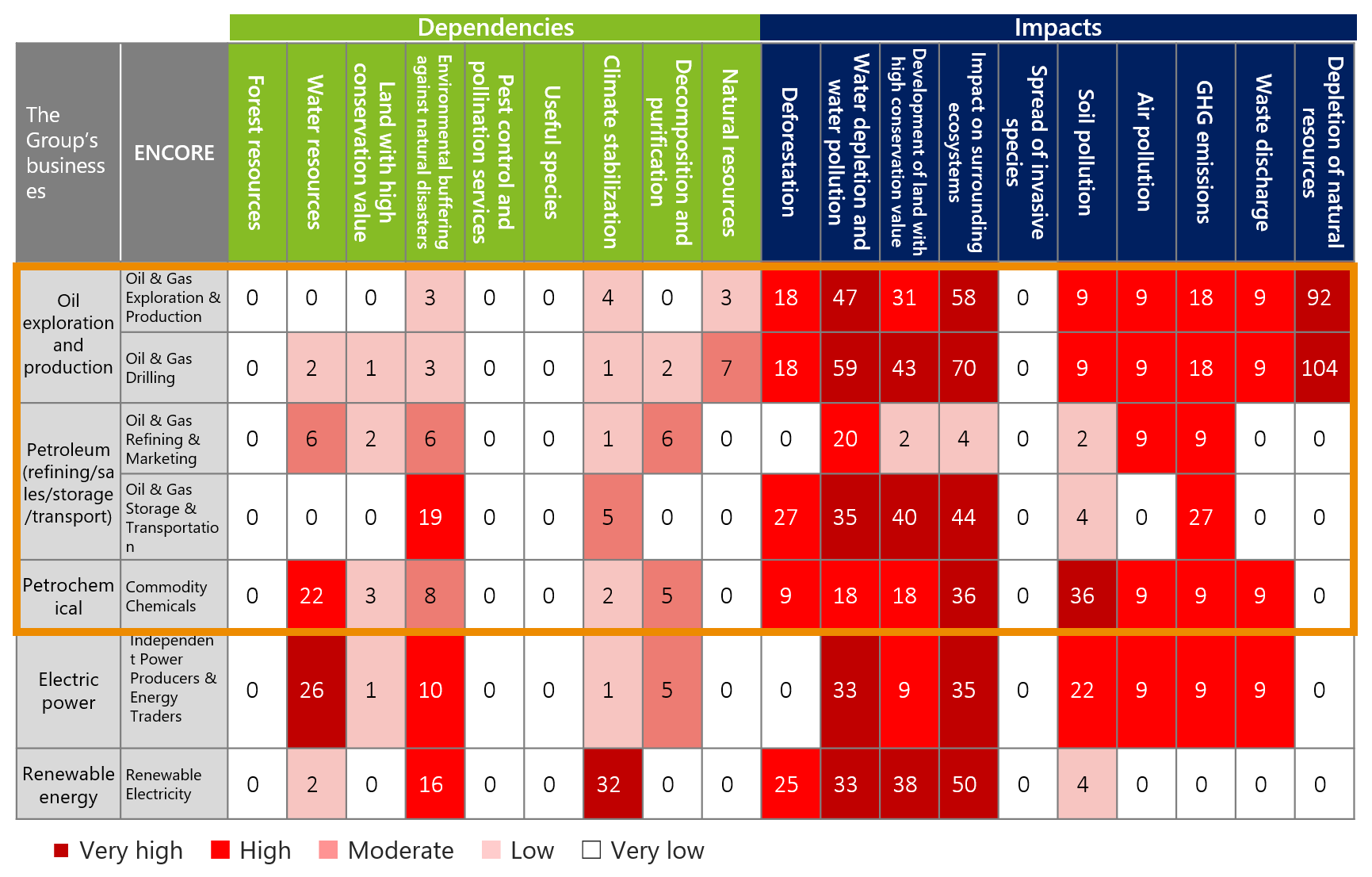
Note: The figures were generated by quantifying the ENCORE risk categories using five levels, and adding up the points for each category. The higher the number, the greater the level of impact.
Based on these results, we made an initial step to comply with the TNFD Recommendations. We selected our oil exploration and production, petroleum (refining/storage), and petrochemical businesses as targets for analysis in line with the LEAP approach.
Nature-Related Materiality Map
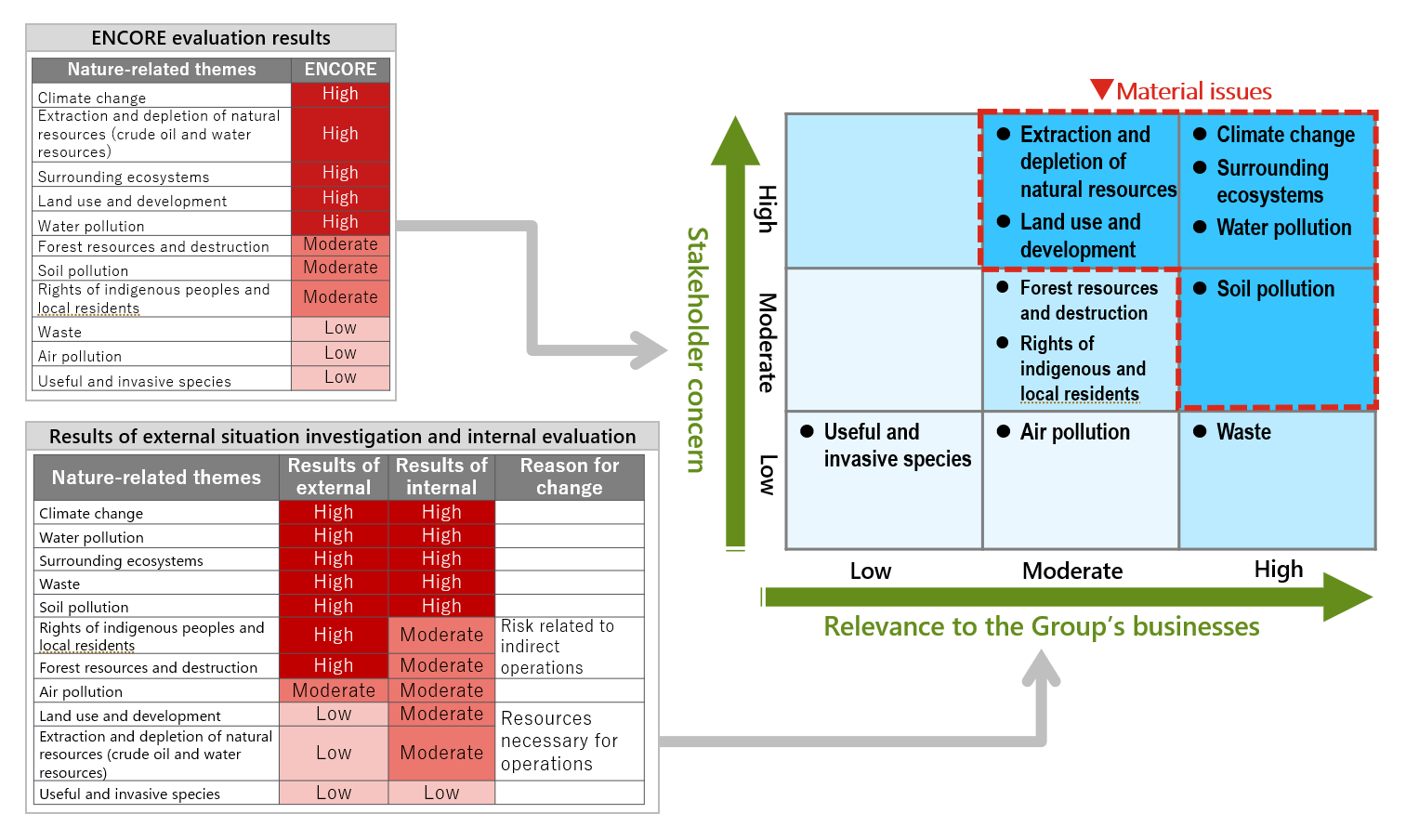
■ Selection of Nature-Related Material Issues
In addition to evaluating our dependencies and impacts using ENCORE, we identified our material issues. We did this by investigating examples of business risks in the value chain, such as new regulatory trends and potential stakeholder criticism of the Group for its impacts on nature. We also specified the relationship between relevant nature-related themes and our value chain.
Using the findings of these investigations and analyses, we evaluated the results using a graph. The scores from the ENCORE analysis of nature-related risks were plotted on the vertical axis as “stakeholder concern level,” while the results of our risk importance assessment were plotted on the horizontal axis as “relevance to our business.” We then added the theme of “rights of indigenous peoples and local residents” to this, and visualized our nature-related risks using a materiality map.
With this materiality map, we identified six nature-related material issues for the Group: climate change, surrounding ecosystems, water pollution, extraction and depletion of natural resources, land use and development, and soil pollution. We then conducted a location analysis.
Location Analysis for Material Issues
■ Business Risks Related to Material Issues
To enable investigation of response measures for the Group’s nature-related material issues, we needed to perform location analysis. Based on their positions in the value chain, we identified operational sites with high potential for material issue risks, and conducted risk assessments for those sites.
As part of material issue analysis, we conducted a location analysis using the scenario of a crude oil or petroleum spill at a major site operated directly by the Group. This was based on the assumption that such an oil spill would have an especially large business impact, making it a significant risk.
In addition, we excluded the two material issues of “climate change” and “extraction and depletion of natural resources” from the location analysis because there are no regional differences and freshwater intake is low for relevant sites.
Value Chain and Nature-Related Material Issues and Business Risks
■ Specification of Priority Locations for Material Issues
When assessing the impact of a potential oil or petroleum spill, we checked for areas of biodiversity importance within a radius of 200 kilometers from the Group’s main offshore oil fields, and within 30 kilometers of our coastal operation sites in Japan.
Coastal and Offshore Sites
Using the IBAT biodiversity risk measurement tool and the marine habitat distribution tool Ocean+ Habitats,4 we assessed our biodiversity risks and conducted a priority location analysis of areas deemed to be particularly susceptible to natural impacts. As a result, we found that the areas surrounding six Group sites, one located off the coast of the Emirate of Abu Dhabi, as well as others in Hokkaido, Chiba Prefecture, Mie Prefecture, and Osaka Prefecture, include some areas of biodiversity importance.
4. Ocean + Habitats: An online provider of information on marine habitats worldwide, including their health, distribution, and recent changes. It also offers practical data useful for the conservation and restoration of marine ecosystems./span>
Location Analysis Examples (IBAT)
Inland Sites
Using the biodiversity risk measurement tool, IBAT, and the water risk assessment tool, Water Risk Filter,5 we evaluated nature-related material issues for sites directly operated by the Group and identified our priority locations. This was done based on information such as areas of importance for biodiversity and surrounding water pollution levels.
As a result, we determined that none of our inland sites have any areas of importance for biodiversity within their vicinity.
5. Water Risk Filter: An online tool developed by the World Wide Fund for Nature (WWF) and a German company to evaluate water risks near corporate sites
Based on the above results, six sites, including the area off the coast of the Emirate of Abu Dhabi and five sites within Japan, were identified as priority locations. This was due to the presence of priority areas in terms of biodiversity, water pollution, soil pollution, and coral and mangrove habitats.
Evaluation Based on Value Chain Location Analysis
Note: Key Biodiversity Area (KBA): Important area for biodiversity conservation
■ Identification of Ecosystem Services and Natural Capital Requiring Consideration at Operational Sites
Selection of High-Impact Operational Sites
To understand the specific impacts of our business activities on natural capital, as well as the degree to which our operations depend on nature, we conducted a desktop assessment of the inland sites identified above as “priority locations” requiring particular attention. This assessment was carried out using the following criteria.
[Criteria for Site Selection]
• Sites associated with business sectors that, according to ENCORE sector analysis, have high dependency on and significant impact on nature
• Operational sites representing large-scale business sectors within the Group and serving as flagship locations
[Selected Sites]
Chiba Refinery (refining), Chiba Plant (petrochemicals)
Identification of Ecosystem Services and Natural Capital Relevant to Operational Sites
To identify ecosystem services and natural capital closely linked to high-impact operational sites, we conducted evaluations incorporating both ENCORE analysis and expert insights from specialists in natural capital. These evaluations considered region-specific natural features, enabling us to identify the ecosystem services and natural capital elements that warrant particular attention at each selected site.
| Overview of Ecosystem Services and Potential Nature-Related Dependencies | ||||
| No | Natural Capital | Major Ecosystem Services | Specific Relationships | Associated Locations |
|---|---|---|---|---|
| 1 | Water | Water flow regulation | [Land Use (Factory Operations)] The maintenance of ecosystem services such as water flow regulation and soil retention around operational sites may help prevent water-related disasters such as heavy rainfall-induced flooding. |
Yoro River basin adjacent to sites |
| Soil | Soil retention | |||
| 2 | Habitat species | Local climate regulation | [Manufacturing] Vegetation surrounding operational sites can mitigate noise from manufacturing activities and reduce the impact of any potential stress on local residents such as odors emitted during production. |
Natural environment surrounding the site, including green spaces within sites |
| Noise and odor mitigation | ||||
| 3 | Water | Water purification | [Waste] The dilution of pollutants generated during petroleum refining may potentially rely on ecosystem services such as the purification of water and air. |
Entire natural environment surrounding sites, including Yoro River basin and Tokyo Bay |
| Air | Dilution by air and ecosystems | |||
| Natural Capital Potentially Impacted | ||||
| No | Natural Capital | Impact Drivers | Specific Relationships | Associated Locations |
| 1 | Habitat species | Disturbance (light, noise) | [Factory Operations] Light and noise generated by factory operations may potentially impact wildlife inhabiting the surrounding area. |
Natural environment surrounding sites, including green spaces within sites |
| 2 | Habitat species | Water pollution Soil contamination |
[Waste] Discharge from petroleum refining processes may lead to water pollution caused by chemical substances and an excess of nutrients, which can harm the surrounding natural environment and affect local water, wildlife, and soil conditions. |
Yoro River basin and Tokyo Bay, which are adjacent to sites |
| Water | ||||
| Soil | ||||
Expansion to Other Operational Sites
The ecosystem services and natural capital identified above as requiring attention at the Chiba Refinery and Chiba Plant are similarly relevant to other operational sites engaged in the same business activities. Accordingly, we have organized information on the associated natural environments and species that merit consideration with respect to ecosystem services and natural capital — not only for these facilities in Chiba, but also for other relevant sites.
| Site | Associated Locations | Status of Use by Representative Species |
|---|---|---|
Chiba Refinery and Chiba Plant (Ichihara City, Chiba Prefecture) |
Tokyo Bay | Birds such as greater scaup, grey plover, ruddy turnstone, dunlin, sanderling, grey-tailed tattler, and Eurasian whimbrel that migrate to Tokyo Bay1 |
| Yoro River | Seafloor organisms inhabiting the tidal flats at the mouth of the Yoro River, known for high biodiversity and confirmed presence of many endangered and rare species2 | |
Yokkaichi Refinery and Yokkaichi Plant (Yokkaichi City, Mie Prefecture) |
Ise Bay | Birds such as grey plover, dunlin, grey-headed lapwing, Kentish plover, and Siberian sand plover that migrate to the Fujimae Tidal Flat, located at the confluence of the Shonai, Shin, and Nikko Rivers in the innermost part of Ise Bay2 |
| Suzuka River | Birds such as plovers and sandpipers that use the area around the mouth of the Suzuka River as a stopover site2 | |
Sakai Refinery (Sakai City, Osaka Prefecture) Osaka Plant (Osaka City, Osaka Prefecture) |
Osaka Bay | • Seafloor organisms such as Yamato Shijimi (Corbicula japonica, a brackish water clam) that inhabit the tidal flats at the mouth of the Yodo River, and birds such as plovers and sandpipers that use the Osaka Nanko Bird Sanctuary as a migratory stop2 • Fish species such as stone flounder, marbled flounder, olive flounder, gazami crab, kuruma prawn, Richard's dragonet, Japanese sea bass, and konoshiro gizzard shad that use Osaka Bay as a spawning ground2 |
Shimotsu Plant (Kainan City, Wakayama Prefecture) |
Shimotsu Port | Fish species inhabiting Shimotsu Bay |
Matsuyama Plant (Matsuyama City, Ehime Prefecture) |
Shigenobu River | Seafloor organisms with high biodiversity and birds such as plovers and sandpipers that inhabit the tidal flats at the mouth of the Shigenobu River and use it as a migratory site2 |
| Risk Types | Assumed Nature-Related Risk Scenarios | |
|---|---|---|
| Physical risks | Acute risks | Potential degradation and loss of regional natural capital due to external factors not caused by the Group such as flooding |
| Potential degradation and loss of regional natural capital due to accidental leakage of pollutants into water or soil | ||
| Chronic risks | Potential degradation and loss of regional natural capital due to cumulative leakage of pollutants into water or soil | |
| Transition risks | Policy risks | Strengthening of regulations and ordinances related to water quality protection, water intake, and pollution |
| Mandatory use of environmentally friendly raw materials and tightening of regulations on hazardous substances | ||
| Market risks | Risk of declining asset value and pressure on corporate market value due to the need for capital investment in newer, more efficient technologies | |
| Technology risks | Rising costs associated with the introduction of equipment and machinery to improve resource efficiency | |
| Reputational risks | Reputational, litigation, and boycott risks stemming from environmental degradation in surrounding areas | |
| Liability risks | Liability for damages related to pollution incidents such as oil spills | |
| Opportunity Types | Assumed Nature-Related Opportunity Scenarios |
|---|---|
| Business performance | • Development of new business opportunities in technical fields such as water quality management and oil spill prevention • Risk mitigation through the promotion and expansion of renewable energy initiatives • Improved public perception through the disclosure of risk avoidance measures and response strategies |
| Sustainability performance | • Sustainable use of regional natural capital through operations that proactively avoid environmental risks • Better conservation of the broader regional natural environment driven by increased awareness within the Group and among local community stakeholders |
Investigation of Response Measures
■ Responding to Material Issues
At the six sites identified as priority locations, we assessed the risk of environmental impact from an oil spill, which would have a large impact on society and consequences for business continuity. We confirmed that the sites have already implemented various measures at this stage, including impact mitigation strategies based on past incidents and spill prevention measures. If any changes occur in operations or the surrounding environment going forward, we will consider additional response measures as necessary.
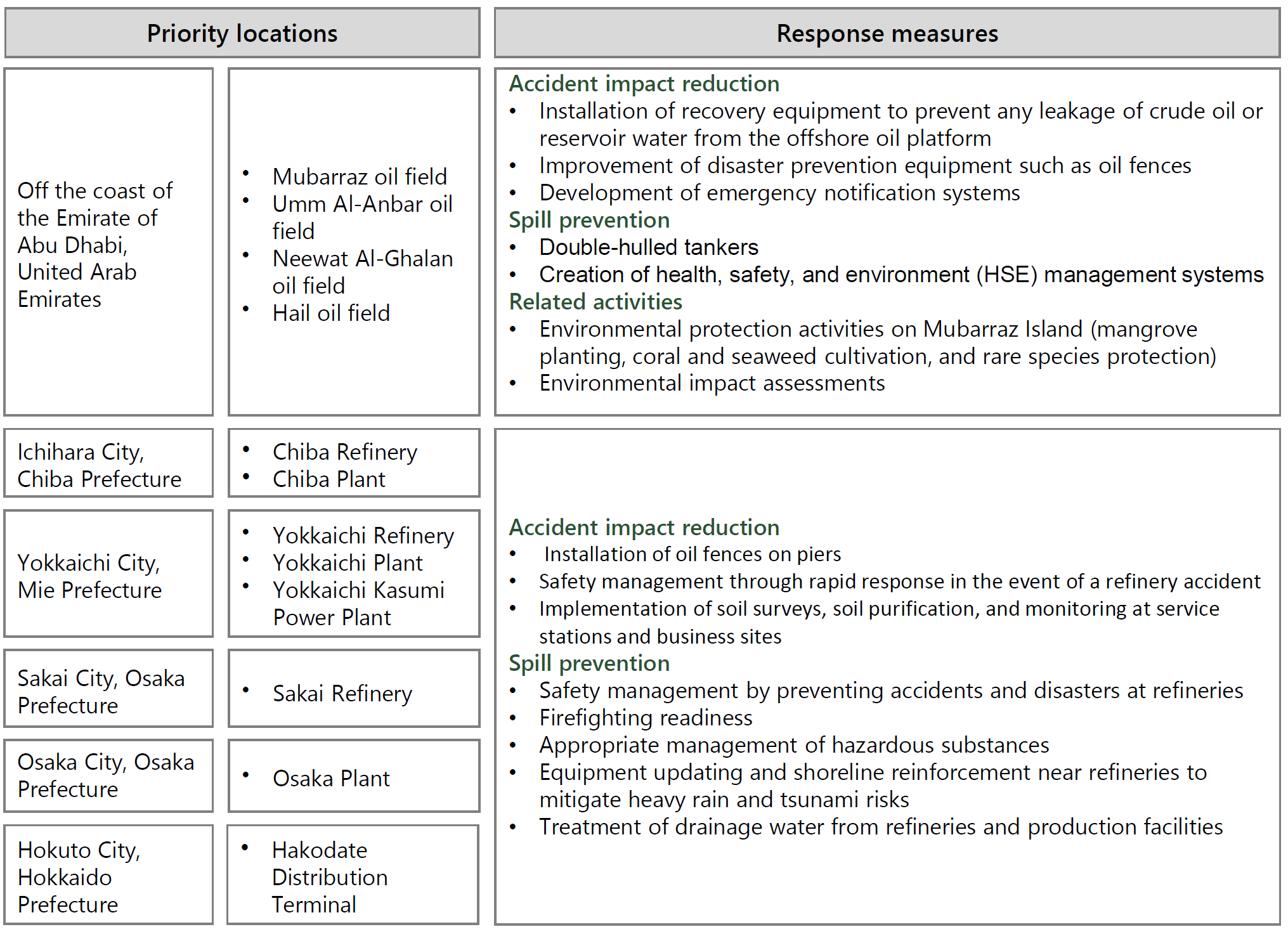
■ Site-Specific Measures for Priority Locations
The following effective measures have already been implemented at our operational sites in response to identified nature-related risks.
• Compliance with additional environmental standards set by prefectural authorities
• Monitoring of emissions and transfers of substances subject to the Pollutant Release and Transfer Register Law (PRTR Law)
• Regular inspection of facilities related to the management of regulated substances and oil spill prevention
• Switchover to LED lighting
• Implementation of noise control measures in accordance with Japan’s Noise Regulation Act
■ Measures for the Renewable Energy Business
In the renewable energy area, Cosmo Eco Power, which operates the Group’s wind power business, conducts legally required environmental assessments before starting any projects. After operations begin, follow-up surveys are carried out and environmental management is promoted according to the results of these assessments.
Based on this, we believe that our nature impact risks have been mitigated. If necessary, however, we will consider additional location analysis, and expand the scope of the business impact analysis.
Indicators and Targets
Quantitative Indicators
The Group recognizes climate change as one of its nature-related material issues, and has compiled and disclosed relevant indicators on its TCFD page.
Please refer to the link below for more information on indicators and targets.
Addressing Climate Change — Support for the TCFD Recommendations
■ TNFD’s Core Global Indicators
The TNFD recommends that companies select a total of 14 metrics as core global indicators. This includes nine indicators related to dependencies and impacts on nature, and five indicators related to nature-related risks and opportunities. Companies are also expected to release their indicator data.
The situation for disclosure of the Group’s core global dependency and impact indicators is described in the following section.
Core Global Dependency and Impact Indicators and Metrics
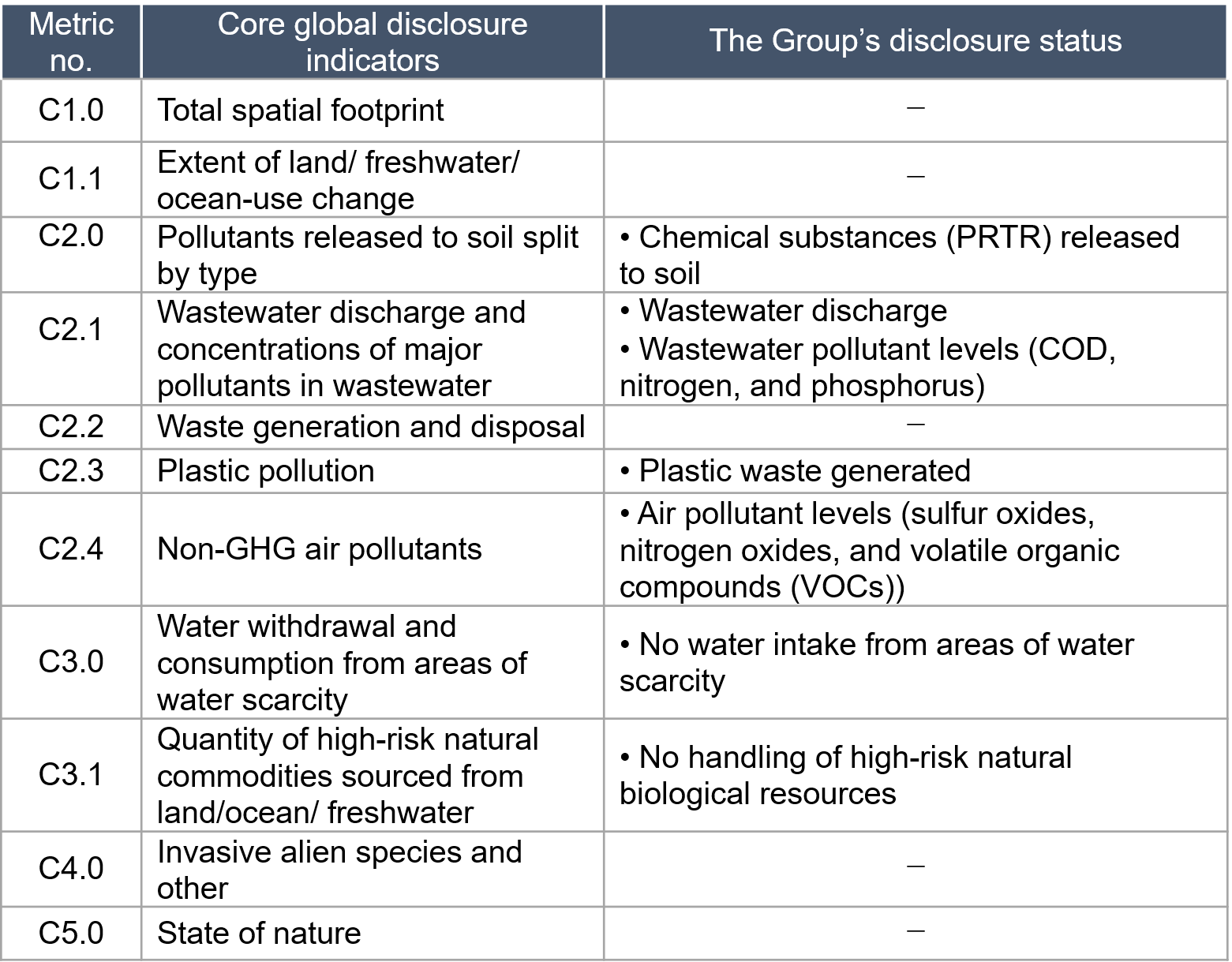
For indicators that are difficult to provide, we plan to expand disclosure by collecting data and conducting more detailed analysis. At the same time, we will also consider disclosing the core global indicators related to risks and opportunities in future surveys.
For information on our chemical substance management, wastewater discharge, and wastewater and air pollution levels, etc., please refer to “Initiatives for Reducing Environmental Impact.” For actual values, see the relevant items in ESG Data.
Quantitative Targets
■ Efforts to Help Achieve International Targets
Cosmo Energy Holdings has declared its support for the Keidanren Declaration for Biodiversity and Guideline. To fulfill the role of companies set out in this guideline, we are taking action to address the nine areas indicated.
Cosmo Energy Holdings joined the TNFD Forum in October 2023 and the 30by30 Alliance for Biodiversity launched by Japan’s Ministry of the Environment in November 2023.
The term “30 by 30” refers to the goal of effectively conserving 30% of the planet’s terrestrial and marine habitats by 2030. This is a nature-positive initiative that aims to halt the loss of biodiversity and to ensure a net positive impact on the natural environment.
Through our participation in this alliance, we will step up our efforts to conserve biodiversity and natural capital in order to help achieve the 30 by 30 goal.
We will also consider setting indicators and targets that are aligned with the TNFD’s core global dependency and impact indicators.
Environmental Protection Activities in Oil-Producing Countries
Cosmo Energy Exploration & Production is continually working to protect the environment and promote the sustainable use of natural resources.
Mubarraz Island, where Abu Dhabi Oil, a group company of Cosmo Energy Exploration & Production operates, has an extremely beautiful coastline that requires special environmental considerations. Based on an understanding of the responsibilities that come with working within a marine reserve, the company implements effective management and monitoring programs to protect the coastal ecosystem and the wildlife that depend on it.
At Mubarraz Island, which is a site for oil production, the company is also prioritizing and undertaking a wide range of environmental protection activities such as greening, including the planting of mangroves, coral reef farming, propagation of sea grass, and protection of a local osprey species.




Mangrove Planting Activities
Abu Dhabi Oil, a group company of Cosmo Energy Exploration & Production, has been engaged in mangrove planting on Mubarraz Island for over 35 years.
More than 500,000 mangrove seedlings have been transplanted from a dedicated nursery facility. Despite the harsh climatic and geographical conditions of the United Arab Emirates, the company has created an environment suitable for mangrove growth by adjusting water depth using artificial channels and improving soil quality.
Specifically, artificial tidal channels were excavated along coastal levees and mangroves were transplanted there, reinforcing existing man-made infrastructure with a natural wave barrier. This innovative approach enables mangroves to function as living breakwaters, helping to prevent coastal erosion caused by waves.
To date, mangrove growth has been confirmed along approximately seven kilometers of coastline, representing about 20% of the levee area. Looking ahead, Abu Dhabi Oil plans to expand planting across an additional nine kilometers of coastline.
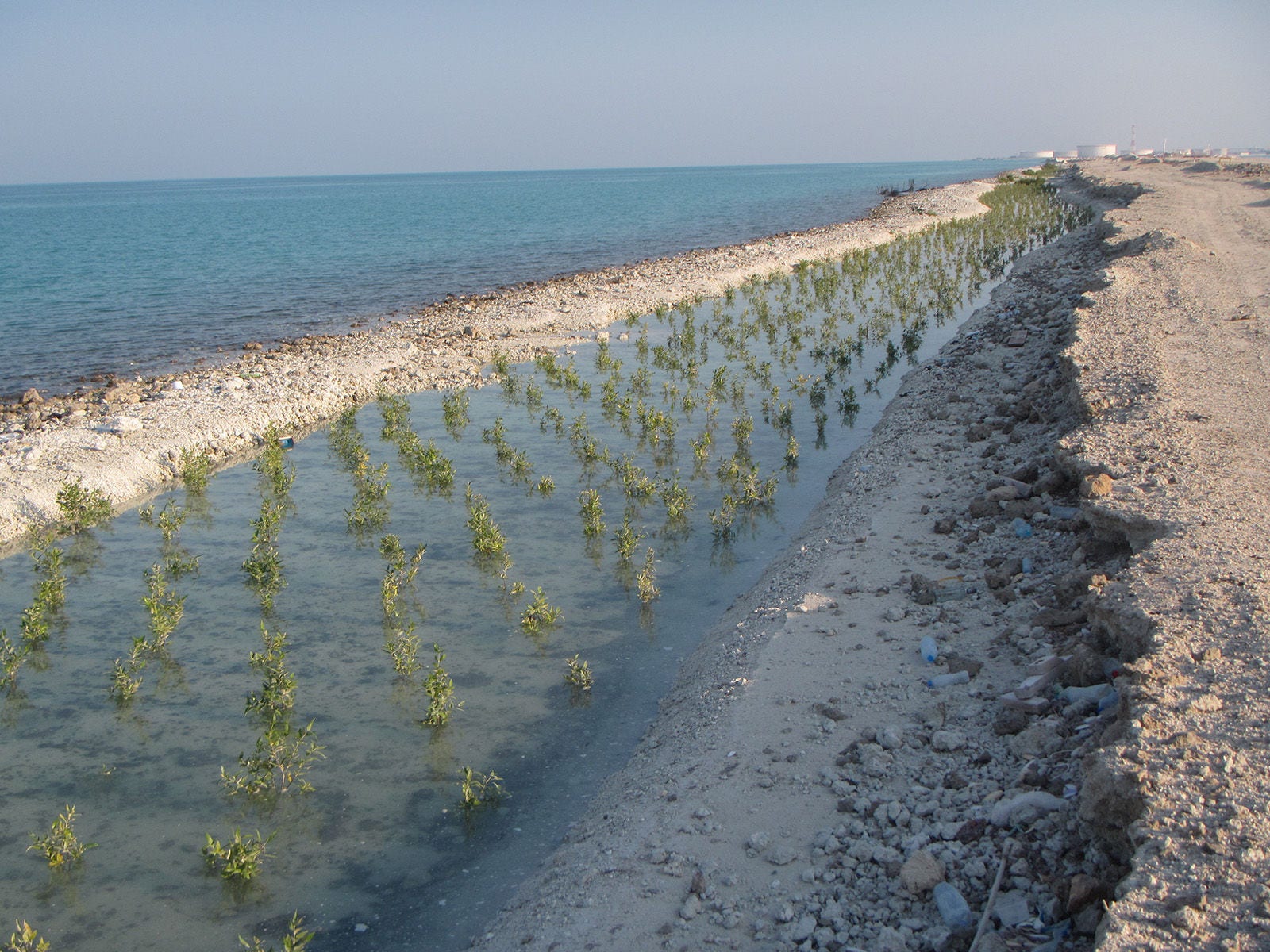
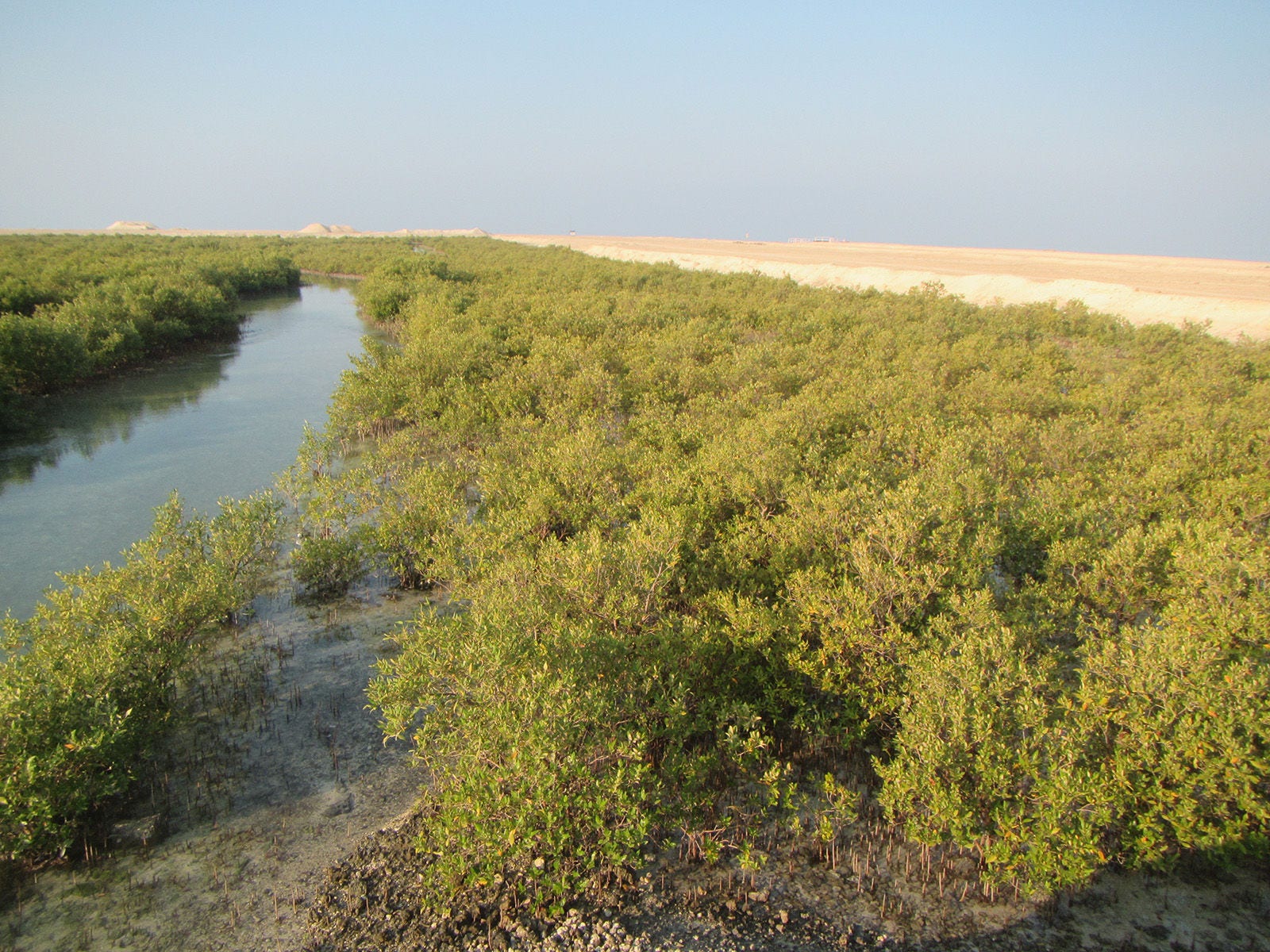
Mangroves planted along an artificial tidal channel
Benefits of Mangrove Planting
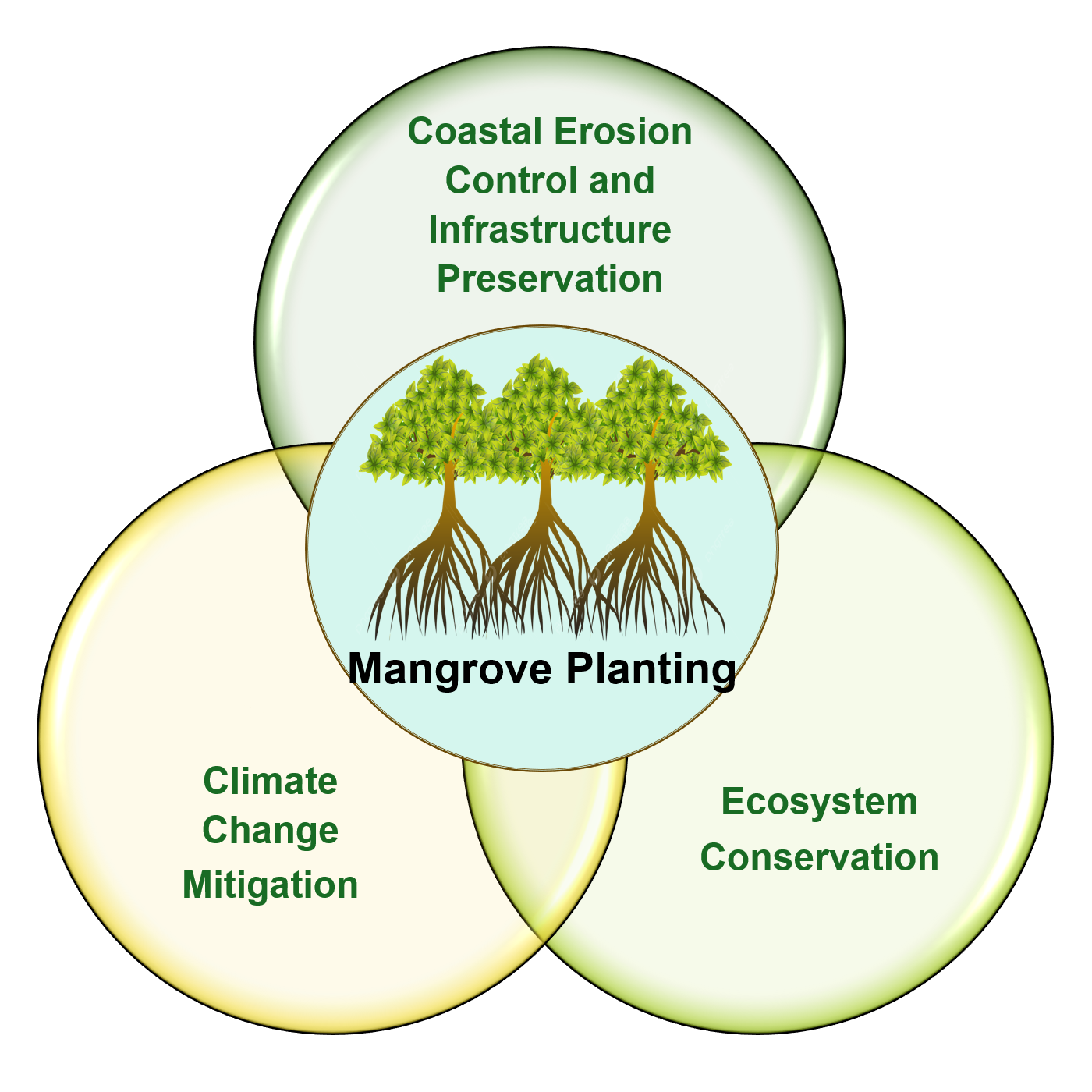
🌍 Climate Change Mitigation (Absorbing Approximately 37 Tons of CO₂ Annually)
Mangroves have the capacity to store three to five times more carbon compared to terrestrial forests of the same area. The 17.5-hectare mangrove forest established on Mubarraz Island absorbs and sequesters approximately 37 tons of CO₂ annually (as of 2022).
🛡 Coastal Erosion Control and Coastal Infrastructure Protection (Maintenance Costs Reduced to One-Sixth)
We have adopted the “Engineering With Nature” approach, which involves planting mangroves between seawalls and protective embankments along the coast.1 This method has reduced maintenance costs to approximately one-sixth compared to conventional hard engineering techniques that use steel sheet piles.
1. Engineering With Nature (EWN)
🐦 Ecosystem Conservation (Habitat for Over 60 Species)
The planted mangrove forest has become home to over 60 species of birds, crabs, fish, and other wildlife, fostering a rich ecosystem. This initiative has achieved significant results not only in environmental conservation but also in biodiversity preservation.
Ecosystem Conservation Survey
Although Mubarraz Island was originally devoid of vegetation, the relatively recent construction of artificial tidal channels and subsequent mangrove planting have significantly promoted the establishment of local fauna, contributing to high biodiversity. These efforts have led to the successful colonization by seafloor invertebrates and increased bird diversity.
Colonization by seafloor invertebrates
• Crab burrows: up to 638 per m²
• Gastropods: up to 429 per m²
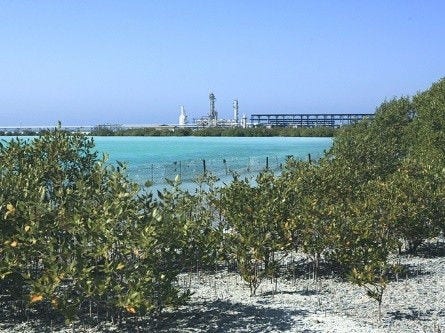
Increased bird diversity
• Number of species observed: 50
• Confirmed breeding: at least 6 species (within mangrove forests)
• Migratory birds: 12 species (including plovers and sandpipers)

Biodiversity Activities of the COSMO Eco Fund
With a commitment to conserving biodiversity, the COSMO Eco Fund supports projects such as rural Japanese landscape (satoyama) conservation activities and forest restoration projects where participants can learn about biodiversity.
For more details on these activities, please refer to the Project Introduction page for the COSMO Eco Fund.
